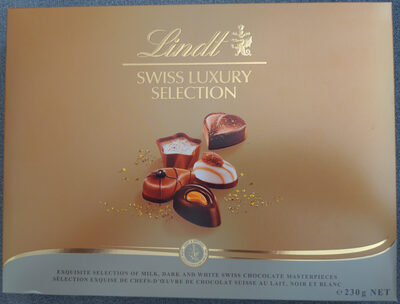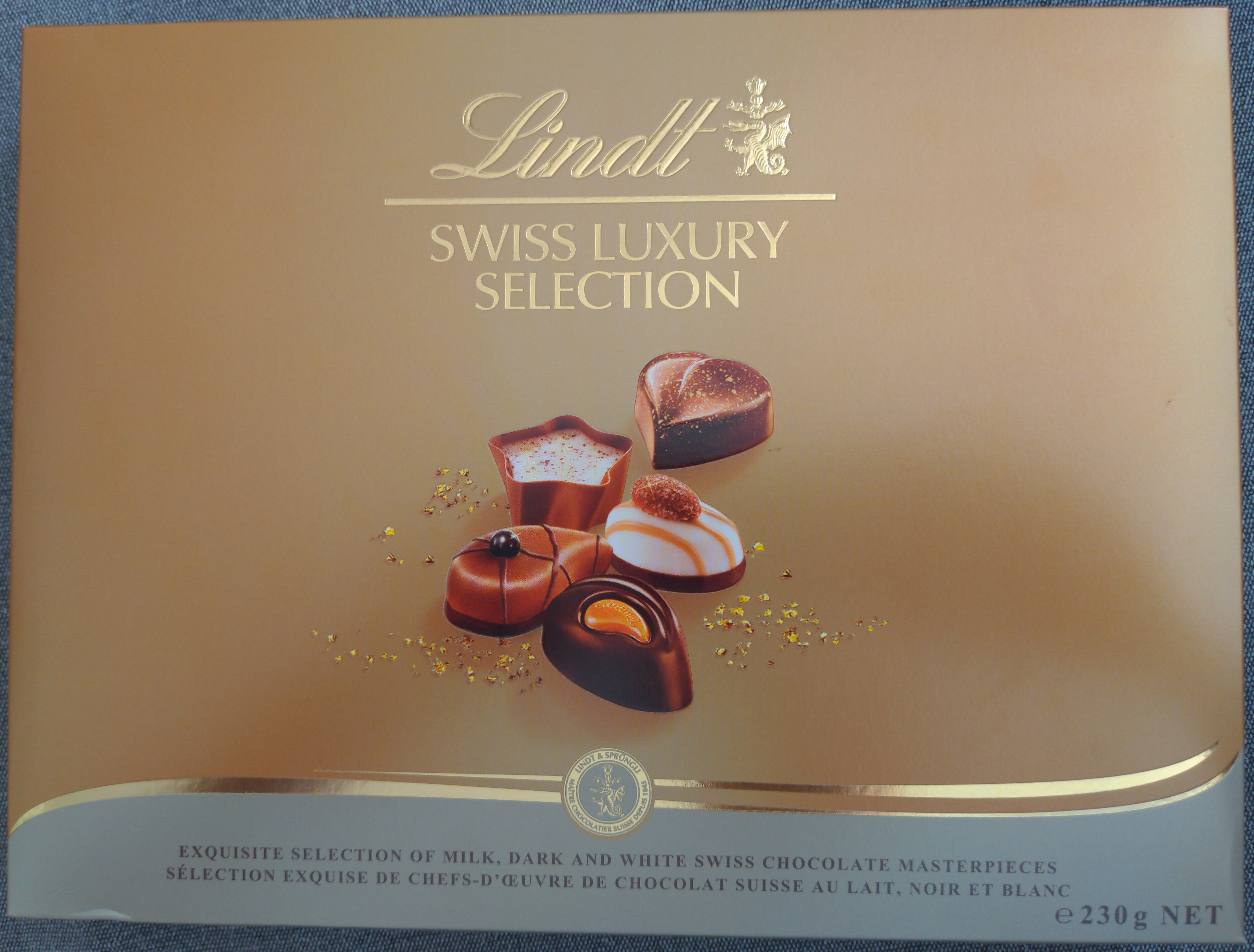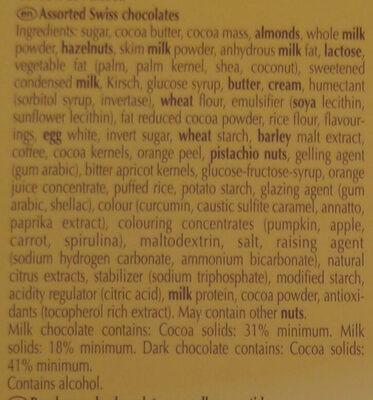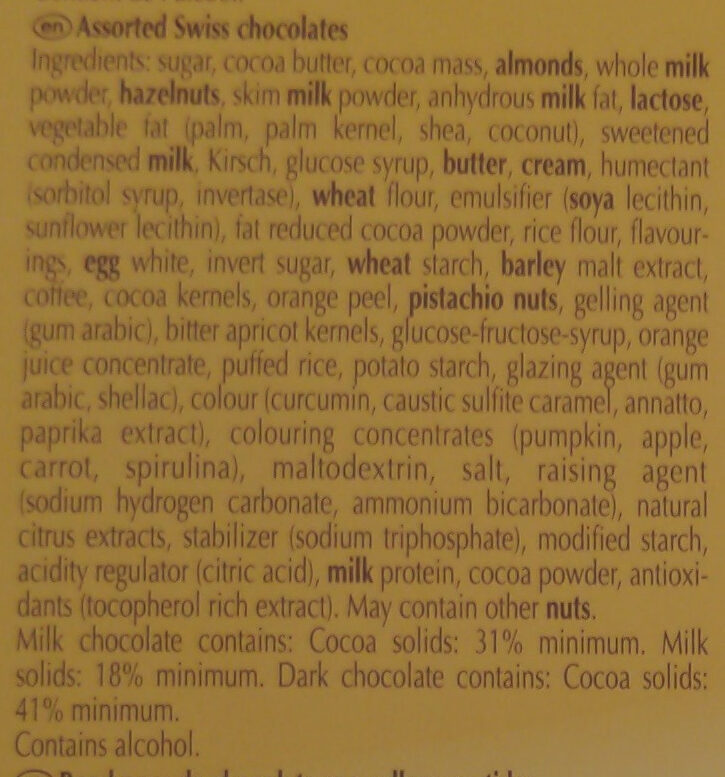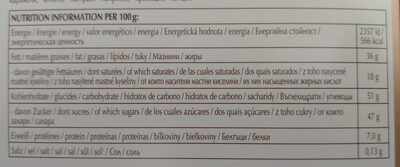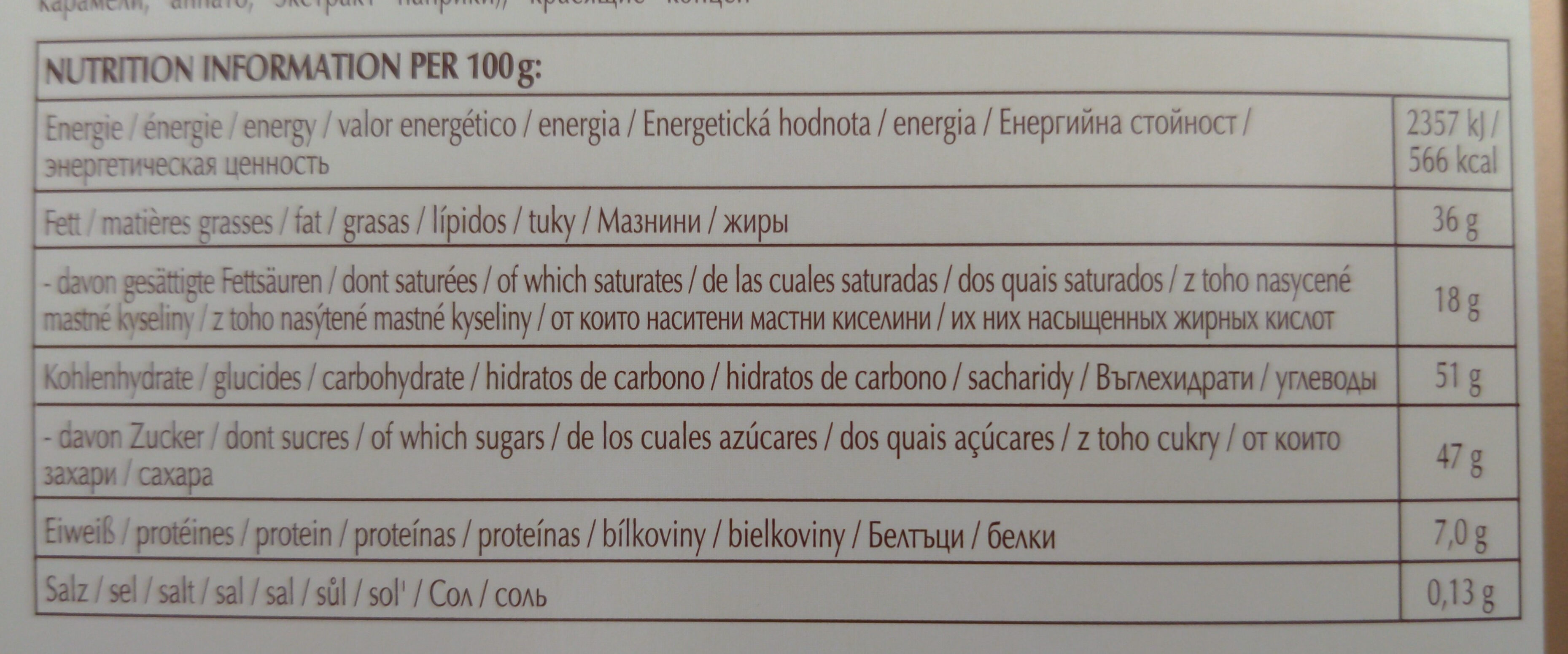Help us make food transparency the norm!
As a non-profit organization, we depend on your donations to continue informing consumers around the world about what they eat.
The food revolution starts with you!
Swiss luxury selection - Lindt - 230 g
Swiss luxury selection - Lindt - 230 g
This product page is not complete. You can help to complete it by editing it and adding more data from the photos we have, or by taking more photos using the app for Android or iPhone/iPad. Thank you!
×
Barcode: 7610400075503 (EAN / EAN-13)
Quantity: 230 g
Packaging: Cardboard
Brands: Lindt
Categories: Snacks, Sweet snacks, Cocoa and its products, Confectioneries, Chocolate candies, Bonbons, Assorted chocolate candies
Countries where sold: Brazil, Luxembourg
Matching with your preferences
Health
Ingredients
-
78 ingredients
Sugar, cocoa butter, cocoa mass, almonds, whole milk powder, hazelnuts, skim milk powder, anhydrous milk fat, lactose, vegetable fat (palm, palm kernel, shea, coconut), sweetened condensed milk, Kirsch, glucose syrup, butter, cream, humectant (sorbitol syrup, invertase), wheat flour, emulsifier (soya lecithin, sunflower lecithin), fat reduced cocoa powder, rice flour, flavourings, egg white, invert sugar, wheat starch, barley malt extract, coffee, cocoa kernels, orange peel, pistachio nuts, gelling agent (gum arabic), bitter apricot kernels, glucose-fructose-syrup, orange juice concentrate, puffed rice, potato starch, glazing agent (gum arabic, shellac), colour (curcumin, caustic sulfite caramel, annatto, paprika extract), colouring concentrates (pumpkin, apple, carrot, spirulina), maltodextrin, salt, raising agent (sodium hydrogen carbonate, ammonium bicarbonate), natural citrus extracts, stabilizer (sodium triphosphate), modified starch, acidity regulator (citric acid), milk protein, cocoa powder, antioxi - dants (tocopherol rich extract). May contain other nuts. Milk chocolate contains: Cocoa solids: 31% minimum. Milk solids: 18% minimum. Dark chocolate contains: Cocoa solids: 41% minimum. Contains alcohol.Allergens: Apple, Eggs, Gluten, Milk, Nuts, SoybeansTraces: Nuts
Food processing
-
Ultra processed foods
Elements that indicate the product is in the 4 - Ultra processed food and drink products group:
- Additive: E100 - Curcumin
- Additive: E14XX - Modified Starch
- Additive: E150 - Caramel
- Additive: E160b - Annatto
- Additive: E160c - Paprika extract
- Additive: E322 - Lecithins
- Additive: E414 - Acacia gum
- Additive: E420 - Sorbitol
- Additive: E451 - Triphosphates
- Additive: E904 - Shellac
- Ingredient: Colour
- Ingredient: Emulsifier
- Ingredient: Flavouring
- Ingredient: Gelling agent
- Ingredient: Glazing agent
- Ingredient: Glucose
- Ingredient: Glucose syrup
- Ingredient: Humectant
- Ingredient: Invert sugar
- Ingredient: Lactose
- Ingredient: Maltodextrin
- Ingredient: Milk proteins
Food products are classified into 4 groups according to their degree of processing:
- Unprocessed or minimally processed foods
- Processed culinary ingredients
- Processed foods
- Ultra processed foods
The determination of the group is based on the category of the product and on the ingredients it contains.
Additives
-
E1103 - Invertase
Invertase: Invertase is an enzyme that catalyzes the hydrolysis -breakdown- of sucrose -table sugar- into fructose and glucose. Alternative names for invertase include EC 3.2.1.26, saccharase, glucosucrase, beta-h-fructosidase, beta-fructosidase, invertin, sucrase, maxinvert L 1000, fructosylinvertase, alkaline invertase, acid invertase, and the systematic name: beta-fructofuranosidase. The resulting mixture of fructose and glucose is called inverted sugar syrup. Related to invertases are sucrases. Invertases and sucrases hydrolyze sucrose to give the same mixture of glucose and fructose. Invertases cleave the O-C-fructose- bond, whereas the sucrases cleave the O-C-glucose- bond.For industrial use, invertase is usually derived from yeast. It is also synthesized by bees, which use it to make honey from nectar. Optimal temperature at which the rate of reaction is at its greatest is 60 °C and an optimum pH of 4.5. Typically, sugar is inverted with sulfuric acid.Source: Wikipedia
-
E322 - Lecithins
Lecithins are natural compounds commonly used in the food industry as emulsifiers and stabilizers.
Extracted from sources like soybeans and eggs, lecithins consist of phospholipids that enhance the mixing of oil and water, ensuring smooth textures in various products like chocolates, dressings, and baked goods.
They do not present any known health risks.
-
E322i - Lecithin
Lecithins are natural compounds commonly used in the food industry as emulsifiers and stabilizers.
Extracted from sources like soybeans and eggs, lecithins consist of phospholipids that enhance the mixing of oil and water, ensuring smooth textures in various products like chocolates, dressings, and baked goods.
They do not present any known health risks.
-
E330 - Citric acid
Citric acid is a natural organic acid found in citrus fruits such as lemons, oranges, and limes.
It is widely used in the food industry as a flavor enhancer, acidulant, and preservative due to its tart and refreshing taste.
Citric acid is safe for consumption when used in moderation and is considered a generally recognized as safe (GRAS) food additive by regulatory agencies worldwide.
-
E414 - Acacia gum
Gum arabic: Gum arabic, also known as acacia gum, arabic gum, gum acacia, acacia, Senegal gum and Indian gum, and by other names, is a natural gum consisting of the hardened sap of various species of the acacia tree. Originally, gum arabic was collected from Acacia nilotica which was called the "gum arabic tree"; in the present day, gum arabic is collected from acacia species, predominantly Acacia senegal and Vachellia -Acacia- seyal; the term "gum arabic" does not indicate a particular botanical source. In a few cases so‐called "gum arabic" may not even have been collected from Acacia species, but may originate from Combretum, Albizia or some other genus. Producers harvest the gum commercially from wild trees, mostly in Sudan -80%- and throughout the Sahel, from Senegal to Somalia—though it is historically cultivated in Arabia and West Asia. Gum arabic is a complex mixture of glycoproteins and polysaccharides. It is the original source of the sugars arabinose and ribose, both of which were first discovered and isolated from it, and are named after it. Gum arabic is soluble in water. It is edible, and used primarily in the food industry as a stabilizer, with EU E number E414. Gum arabic is a key ingredient in traditional lithography and is used in printing, paint production, glue, cosmetics and various industrial applications, including viscosity control in inks and in textile industries, though less expensive materials compete with it for many of these roles. While gum arabic is now produced throughout the African Sahel, it is still harvested and used in the Middle East.Source: Wikipedia
-
E420 - Sorbitol
Sorbitol: Sorbitol --, less commonly known as glucitol --, is a sugar alcohol with a sweet taste which the human body metabolizes slowly. It can be obtained by reduction of glucose, which changes the aldehyde group to a hydroxyl group. Most sorbitol is made from corn syrup, but it is also found in nature, for example in apples, pears, peaches, and prunes. It is converted to fructose by sorbitol-6-phosphate 2-dehydrogenase. Sorbitol is an isomer of mannitol, another sugar alcohol; the two differ only in the orientation of the hydroxyl group on carbon 2. While similar, the two sugar alcohols have very different sources in nature, melting points, and uses.Source: Wikipedia
-
E420ii - Sorbitol syrup
Sorbitol: Sorbitol --, less commonly known as glucitol --, is a sugar alcohol with a sweet taste which the human body metabolizes slowly. It can be obtained by reduction of glucose, which changes the aldehyde group to a hydroxyl group. Most sorbitol is made from corn syrup, but it is also found in nature, for example in apples, pears, peaches, and prunes. It is converted to fructose by sorbitol-6-phosphate 2-dehydrogenase. Sorbitol is an isomer of mannitol, another sugar alcohol; the two differ only in the orientation of the hydroxyl group on carbon 2. While similar, the two sugar alcohols have very different sources in nature, melting points, and uses.Source: Wikipedia
-
E451 - Triphosphates
Sodium triphosphate: Sodium triphosphate -STP-, also sodium tripolyphosphate -STPP-, or tripolyphosphate -TPP-,- is an inorganic compound with formula Na5P3O10. It is the sodium salt of the polyphosphate penta-anion, which is the conjugate base of triphosphoric acid. It is produced on a large scale as a component of many domestic and industrial products, especially detergents. Environmental problems associated with eutrophication are attributed to its widespread use.Source: Wikipedia
-
E451i - Pentasodium triphosphate
Sodium triphosphate: Sodium triphosphate -STP-, also sodium tripolyphosphate -STPP-, or tripolyphosphate -TPP-,- is an inorganic compound with formula Na5P3O10. It is the sodium salt of the polyphosphate penta-anion, which is the conjugate base of triphosphoric acid. It is produced on a large scale as a component of many domestic and industrial products, especially detergents. Environmental problems associated with eutrophication are attributed to its widespread use.Source: Wikipedia
-
E500 - Sodium carbonates
Sodium carbonates (E500) are compounds commonly used in food preparation as leavening agents, helping baked goods rise by releasing carbon dioxide when they interact with acids.
Often found in baking soda, they regulate the pH of food, preventing it from becoming too acidic or too alkaline. In the culinary world, sodium carbonates can also enhance the texture and structure of foods, such as noodles, by modifying the gluten network.
Generally recognized as safe, sodium carbonates are non-toxic when consumed in typical amounts found in food.
-
E500ii - Sodium hydrogen carbonate
Sodium hydrogen carbonate, also known as E500ii, is a food additive commonly used as a leavening agent.
When added to recipes, it releases carbon dioxide gas upon exposure to heat or acids, causing dough to rise and resulting in a light, fluffy texture in baked goods.
It is generally recognized as safe (GRAS) by regulatory authorities when used in appropriate quantities and poses no significant health risks when consumed in typical food applications.
-
E503 - Ammonium carbonates
Ammonium carbonate: Ammonium carbonate is a salt with the chemical formula -NH4-2CO3. Since it readily degrades to gaseous ammonia and carbon dioxide upon heating, it is used as a leavening agent and also as smelling salt. It is also known as baker's ammonia and was a predecessor to the more modern leavening agents baking soda and baking powder. It is a component of what was formerly known as sal volatile and salt of hartshorn.Source: Wikipedia
-
E503ii - Ammonium hydrogen carbonate
Ammonium carbonate: Ammonium carbonate is a salt with the chemical formula -NH4-2CO3. Since it readily degrades to gaseous ammonia and carbon dioxide upon heating, it is used as a leavening agent and also as smelling salt. It is also known as baker's ammonia and was a predecessor to the more modern leavening agents baking soda and baking powder. It is a component of what was formerly known as sal volatile and salt of hartshorn.Source: Wikipedia
-
E904 - Shellac
Shellac: Shellac is a resin secreted by the female lac bug, on trees in the forests of India and Thailand. It is processed and sold as dry flakes -pictured- and dissolved in alcohol to make liquid shellac, which is used as a brush-on colorant, food glaze and wood finish. Shellac functions as a tough natural primer, sanding sealant, tannin-blocker, odour-blocker, stain, and high-gloss varnish. Shellac was once used in electrical applications as it possesses good insulation qualities and it seals out moisture. Phonograph and 78 rpm gramophone records were made of it until they were replaced by vinyl long-playing records from the 1950s onwards. From the time it replaced oil and wax finishes in the 19th century, shellac was one of the dominant wood finishes in the western world until it was largely replaced by nitrocellulose lacquer in the 1920s and 1930s.Source: Wikipedia
Ingredients analysis
-
Palm oil
Ingredients that contain palm oil: Palm, Palm kernel oil
-
Non-vegan
Non-vegan ingredients: Whole milk powder, Skimmed milk powder, Butterfat, Lactose, Sweetened condensed milk, Butter, Cream, Egg white, E904, Milk proteins, Milk chocolate, Milk solidsSome ingredients could not be recognized.
We need your help!
You can help us recognize more ingredients and better analyze the list of ingredients for this product and others:
- Edit this product page to correct spelling mistakes in the ingredients list, and/or to remove ingredients in other languages and sentences that are not related to the ingredients.
- Add new entries, synonyms or translations to our multilingual lists of ingredients, ingredient processing methods, and labels.
If you would like to help, join the #ingredients channel on our Slack discussion space and/or learn about ingredients analysis on our wiki. Thank you!
-
Non-vegetarian
Non-vegetarian ingredients: E904Some ingredients could not be recognized.
We need your help!
You can help us recognize more ingredients and better analyze the list of ingredients for this product and others:
- Edit this product page to correct spelling mistakes in the ingredients list, and/or to remove ingredients in other languages and sentences that are not related to the ingredients.
- Add new entries, synonyms or translations to our multilingual lists of ingredients, ingredient processing methods, and labels.
If you would like to help, join the #ingredients channel on our Slack discussion space and/or learn about ingredients analysis on our wiki. Thank you!
-
Details of the analysis of the ingredients
We need your help!
Some ingredients could not be recognized.
We need your help!
You can help us recognize more ingredients and better analyze the list of ingredients for this product and others:
- Edit this product page to correct spelling mistakes in the ingredients list, and/or to remove ingredients in other languages and sentences that are not related to the ingredients.
- Add new entries, synonyms or translations to our multilingual lists of ingredients, ingredient processing methods, and labels.
If you would like to help, join the #ingredients channel on our Slack discussion space and/or learn about ingredients analysis on our wiki. Thank you!
en: Sugar, cocoa butter, cocoa mass, almonds, whole milk powder, hazelnuts, skim milk powder, anhydrous milk fat, lactose, vegetable fat (palm, palm kernel, shea, coconut), sweetened condensed milk, Kirsch, glucose syrup, butter, cream, humectant (sorbitol syrup, invertase), wheat flour, emulsifier (soya lecithin, sunflower lecithin), fat reduced cocoa powder, rice flour, flavourings, egg white, invert sugar, wheat starch, barley malt extract, coffee, cocoa kernels, orange peel, pistachio nuts, gelling agent (gum arabic), bitter apricot kernels, glucose-fructose-syrup, orange juice, puffed rice, potato starch, glazing agent (gum arabic, shellac), colour (curcumin, caustic sulfite caramel, annatto, paprika extract), colouring (pumpkin, apple, carrot, spirulina), maltodextrin, salt, raising agent (sodium hydrogen carbonate, ammonium bicarbonate), natural citrus extracts, stabilizer (sodium triphosphate), modified starch, acidity regulator (citric acid), milk protein, cocoa powder, antioxi, dants (tocopherol rich extract), Milk chocolate contains 31% (Cocoa solids), Milk solids 18% (Dark chocolate contains), Cocoa solids 41%- Sugar -> en:sugar - vegan: yes - vegetarian: yes - ciqual_proxy_food_code: 31016
- cocoa butter -> en:cocoa-butter - vegan: yes - vegetarian: yes - ciqual_food_code: 16030
- cocoa mass -> en:cocoa-paste - vegan: yes - vegetarian: yes - ciqual_proxy_food_code: 16030
- almonds -> en:almond - vegan: yes - vegetarian: yes - ciqual_food_code: 15041
- whole milk powder -> en:whole-milk-powder - vegan: no - vegetarian: yes - ciqual_food_code: 19021
- hazelnuts -> en:hazelnut - vegan: yes - vegetarian: yes - ciqual_food_code: 15004
- skim milk powder -> en:skimmed-milk-powder - vegan: no - vegetarian: yes - ciqual_food_code: 19054
- anhydrous milk fat -> en:butterfat - vegan: no - vegetarian: yes - from_palm_oil: maybe - ciqual_food_code: 16401
- lactose -> en:lactose - vegan: no - vegetarian: yes
- vegetable fat -> en:vegetable-fat - vegan: yes - vegetarian: yes - from_palm_oil: maybe
- palm -> en:palm - vegan: yes - vegetarian: yes - from_palm_oil: yes - ciqual_food_code: 16129
- palm kernel -> en:palm-kernel-oil - vegan: yes - vegetarian: yes - from_palm_oil: yes
- shea -> en:shea-butter - vegan: yes - vegetarian: yes - from_palm_oil: no
- coconut -> en:coconut - vegan: yes - vegetarian: yes - ciqual_proxy_food_code: 15006
- sweetened condensed milk -> en:sweetened-condensed-milk - vegan: no - vegetarian: yes - ciqual_proxy_food_code: 19051
- Kirsch -> en:kirsch - vegan: maybe - vegetarian: yes - ciqual_food_code: 1014
- glucose syrup -> en:glucose-syrup - vegan: yes - vegetarian: yes - ciqual_proxy_food_code: 31016
- butter -> en:butter - vegan: no - vegetarian: yes - ciqual_proxy_food_code: 16400
- cream -> en:cream - vegan: no - vegetarian: yes - ciqual_food_code: 19402
- humectant -> en:humectant
- sorbitol syrup -> en:e420ii - vegan: yes - vegetarian: yes
- invertase -> en:e1103 - vegan: yes - vegetarian: yes
- wheat flour -> en:wheat-flour - vegan: yes - vegetarian: yes - ciqual_proxy_food_code: 9410
- emulsifier -> en:emulsifier
- soya lecithin -> en:soya-lecithin - vegan: yes - vegetarian: yes - ciqual_food_code: 42200
- sunflower lecithin -> en:sunflower-lecithin - vegan: yes - vegetarian: yes
- fat reduced cocoa powder -> en:fat-reduced-cocoa-powder - vegan: yes - vegetarian: yes - ciqual_food_code: 18100
- rice flour -> en:rice-flour - vegan: yes - vegetarian: yes - ciqual_food_code: 9520
- flavourings -> en:flavouring - vegan: maybe - vegetarian: maybe
- egg white -> en:egg-white - vegan: no - vegetarian: yes - ciqual_food_code: 22001
- invert sugar -> en:invert-sugar
- wheat starch -> en:wheat-starch - vegan: yes - vegetarian: yes - ciqual_proxy_food_code: 9510
- barley malt extract -> en:barley-malt-extract - vegan: yes - vegetarian: yes
- coffee -> en:coffee - vegan: yes - vegetarian: yes - ciqual_proxy_food_code: 18003
- cocoa kernels -> en:cocoa-kernels
- orange peel -> en:orange-zest - vegan: yes - vegetarian: yes - ciqual_proxy_food_code: 13034
- pistachio nuts -> en:pistachio-nuts - vegan: yes - vegetarian: yes - ciqual_food_code: 15044
- gelling agent -> en:gelling-agent
- gum arabic -> en:e414 - vegan: yes - vegetarian: yes
- bitter apricot kernels -> en:bitter-apricot-kernels
- glucose-fructose-syrup -> en:glucose-fructose-syrup - vegan: yes - vegetarian: yes - ciqual_food_code: 31077
- orange juice -> en:orange-juice - vegan: yes - vegetarian: yes - ciqual_proxy_food_code: 2070
- puffed rice -> en:puffed-rice - vegan: yes - vegetarian: yes - ciqual_proxy_food_code: 9100
- potato starch -> en:potato-starch - vegan: yes - vegetarian: yes - ciqual_proxy_food_code: 9510
- glazing agent -> en:glazing-agent
- gum arabic -> en:e414 - vegan: yes - vegetarian: yes
- shellac -> en:e904 - vegan: no - vegetarian: no
- colour -> en:colour
- curcumin -> en:e100 - vegan: yes - vegetarian: yes
- caustic sulfite caramel -> en:e150b - vegan: yes - vegetarian: yes
- annatto -> en:e160b - vegan: yes - vegetarian: yes
- paprika extract -> en:e160c - vegan: yes - vegetarian: yes
- colouring -> en:colour
- pumpkin -> en:pumpkin - vegan: yes - vegetarian: yes - ciqual_food_code: 20139
- apple -> en:apple - vegan: yes - vegetarian: yes - ciqual_food_code: 13050
- carrot -> en:carrot - vegan: yes - vegetarian: yes - ciqual_food_code: 20009
- spirulina -> en:spirulina - vegan: yes - vegetarian: yes - ciqual_proxy_food_code: 20984
- maltodextrin -> en:maltodextrin - vegan: yes - vegetarian: yes
- salt -> en:salt - vegan: yes - vegetarian: yes - ciqual_food_code: 11058
- raising agent -> en:raising-agent
- sodium hydrogen carbonate -> en:e500ii - vegan: yes - vegetarian: yes
- ammonium bicarbonate -> en:e503ii - vegan: yes - vegetarian: yes
- natural citrus extracts -> en:natural-citrus-extracts
- stabilizer -> en:stabiliser
- sodium triphosphate -> en:e451i - vegan: yes - vegetarian: yes
- modified starch -> en:modified-starch - vegan: yes - vegetarian: yes - ciqual_proxy_food_code: 9510
- acidity regulator -> en:acidity-regulator
- citric acid -> en:e330 - vegan: yes - vegetarian: yes
- milk protein -> en:milk-proteins - vegan: no - vegetarian: yes
- cocoa powder -> en:cocoa-powder - vegan: yes - vegetarian: yes - ciqual_food_code: 18100
- antioxi -> en:antioxi
- dants -> en:dants
- tocopherol rich extract -> en:e306 - vegan: yes - vegetarian: yes
- Milk chocolate contains -> en:milk-chocolate - vegan: no - vegetarian: yes - ciqual_food_code: 31004 - percent: 31
- Cocoa solids -> en:cocoa-solids - vegan: yes - vegetarian: yes - ciqual_proxy_food_code: 18100
- Milk solids -> en:milk-solids - vegan: no - vegetarian: yes - ciqual_proxy_food_code: 19051 - percent: 18
- Dark chocolate contains -> en:dark-chocolate - vegan: maybe - vegetarian: yes - ciqual_proxy_food_code: 31074
- Cocoa solids -> en:cocoa-solids - labels: en:contains-alcohol - vegan: yes - vegetarian: yes - ciqual_proxy_food_code: 18100 - percent: 41
Nutrition
-
Bad nutritional quality
⚠ ️Warning: the amount of fiber is not specified, their possible positive contribution to the grade could not be taken into account.⚠ ️Warning: the amount of fruits, vegetables and nuts is not specified on the label, it was estimated from the list of ingredients: 7This product is not considered a beverage for the calculation of the Nutri-Score.
Positive points: 0
- Proteins: 4 / 5 (value: 7, rounded value: 7)
- Fiber: 0 / 5 (value: 0, rounded value: 0)
- Fruits, vegetables, nuts, and colza/walnut/olive oils: 0 / 5 (value: 7.82470760204887, rounded value: 7.8)
Negative points: 27
- Energy: 7 / 10 (value: 2357, rounded value: 2357)
- Sugars: 10 / 10 (value: 47, rounded value: 47)
- Saturated fat: 10 / 10 (value: 18, rounded value: 18)
- Sodium: 0 / 10 (value: 52, rounded value: 52)
The points for proteins are not counted because the negative points are greater or equal to 11.
Nutritional score: (27 - 0)
Nutri-Score:
-
Nutrient levels
-
Fat in high quantity (36%)
What you need to know- A high consumption of fat, especially saturated fats, can raise cholesterol, which increases the risk of heart diseases.
Recommendation: Limit the consumption of fat and saturated fat- Choose products with lower fat and saturated fat content.
-
Saturated fat in high quantity (18%)
What you need to know- A high consumption of fat, especially saturated fats, can raise cholesterol, which increases the risk of heart diseases.
Recommendation: Limit the consumption of fat and saturated fat- Choose products with lower fat and saturated fat content.
-
Sugars in high quantity (47%)
What you need to know- A high consumption of sugar can cause weight gain and tooth decay. It also augments the risk of type 2 diabetes and cardio-vascular diseases.
Recommendation: Limit the consumption of sugar and sugary drinks- Sugary drinks (such as sodas, fruit beverages, and fruit juices and nectars) should be limited as much as possible (no more than 1 glass a day).
- Choose products with lower sugar content and reduce the consumption of products with added sugars.
-
Salt in low quantity (0.13%)
What you need to know- A high consumption of salt (or sodium) can cause raised blood pressure, which can increase the risk of heart disease and stroke.
- Many people who have high blood pressure do not know it, as there are often no symptoms.
- Most people consume too much salt (on average 9 to 12 grams per day), around twice the recommended maximum level of intake.
Recommendation: Limit the consumption of salt and salted food- Reduce the quantity of salt used when cooking, and don't salt again at the table.
- Limit the consumption of salty snacks and choose products with lower salt content.
-
-
Nutrition facts
Nutrition facts As sold
for 100 g / 100 mlAs sold
per serving (10 g)Compared to: Assorted chocolate candies Energy 2,357 kj
(563 kcal)236 kj
(56 kcal)+5% Fat 36 g 3.6 g +8% Saturated fat 18 g 1.8 g +2% Carbohydrates 51 g 5.1 g -1% Sugars 47 g 4.7 g - Fiber ? ? Proteins 7 g 0.7 g +16% Salt 0.13 g 0.013 g -14% Fruits‚ vegetables‚ nuts and rapeseed‚ walnut and olive oils (estimate from ingredients list analysis) 7.825 % 7.825 %
Environment
-
Eco-Score not computed - Unknown environmental impact
We could not compute the Eco-Score of this product as it is missing some data, could you help complete it?Could you add a precise product category so that we can compute the Eco-Score? Add a category
Packaging
-
Packaging with a low impact
-
Packaging parts
(Cardboard)
-
Packaging materials
Material % Packaging weight Packaging weight per 100 g of product Paper or cardboard
-
Transportation
-
Origins of ingredients
Missing origins of ingredients information
⚠ ️ The origins of the ingredients of this product are not indicated.
If they are indicated on the packaging, you can modify the product sheet and add them.
If you are the manufacturer of this product, you can send us the information with our free platform for producers.Add the origins of ingredients for this product Add the origins of ingredients for this product
Threatened species
-
Contains palm oil
Drives deforestation and threatens species such as the orangutan
Tropical forests in Asia, Africa and Latin America are destroyed to create and expand oil palm tree plantations. The deforestation contributes to climate change, and it endangers species such as the orangutan, the pigmy elephant and the Sumatran rhino.
Report a problem
-
Incomplete or incorrect information?
Category, labels, ingredients, allergens, nutritional information, photos etc.
If the information does not match the information on the packaging, please complete or correct it. Open Food Facts is a collaborative database, and every contribution is useful for all.
Data sources
Product added on by openfoodfacts-contributors
Last edit of product page on by roboto-app.
Product page also edited by julian, moon-rabbit, packbot.
